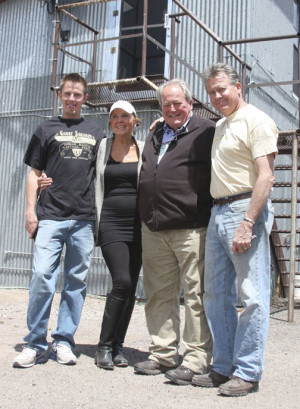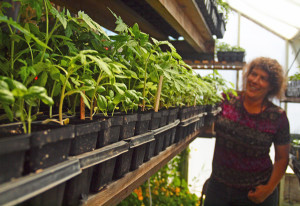by George Sibley
Will work for food: the garden season is upon us again.
We’re learning that with a few wheelbarrows of compost, a few more of aged horse manure, and a lot of “Gunnison Gold” (an earthy mix of wood chips with sludge from the wastewater plant), all mixed and dug in with a fair amount of shovel work, we can coax pretty good potatoes, turnips, rutabagas, carrots, etc. out of the clay hardpan in our yard that won’t grow decent grass.
In this we are part of a growing local “movement” – “locavore,” “urban ag,” whatever you call it – emerging throughout Central Colorado communities that is truly “grassroots.” A lot of us townies down on the ground have just started to grow a growing portion of our own food, with no official encouragement or formal programming. It’s just happening.
Organizations are emerging, like the Upper Gunnison’s “Mountain Roots and Shoots,” to both spread and deepen the “movement.” But it might originally have begun with a kind of visceral consciousness raising. Our consciousnesses got a jolt in 2006 when Denver had a massive blizzard a few days before Christmas. We got almost no snow here in Gunnison from that storm, but we got some serious “fallout” from it. We learned how quickly the supermarket shelves go empty when the big semis are not rolling out of Denver. It’s one thing to observe intellectually (with occasional pontification) that virtually everything we rugged West Slope individualists need to live in the manner to which we are accustomed comes here from somewhere else in trucks, pipes or wires. But it hits home really viscerally when you make your usual run to the grocery store and find the produce and meat counters empty.
To begin growing food in the wake of that experience is undoubtedly a good and positive response to a negative experience. Better to light a candle than curse the darkness, and there is already a massive amount of good and positive literature out there celebrating it. But for the moment, I’ll leave spreading that good news to others. My purpose in writing, here at the beginning of another intensive growing season, is looking at some of the more sobering aspects of local food production. And I have to start with the acknowledgement that I am not the world’s most enthusiastic participant in the locavore movement. I can recognize it as a good thing, a positive thing, something I even really believe in – but all that “head knowledge” does not leave me eager to get down in the dirt and work with, or for, the plants.
My partner is just the opposite. Her favorite winter relaxation is getting in the bathtub with a couple gardening catalogs. The view of winter from our south-facing windows is through a jungle of green plants on shelves I’ve built for her in front of those windows. By mid-March, those flowering plants are joined by trays of vegetable seeds sprouting in little plastic pots on the window shelves. I’m usually conscripted to set up the cold frame on an afternoon when there is a nasty wind blowing with the smell of snow, if not the actual thing. “Isn’t it a little early?” I whine.
She looks forward to getting out in our gardens with unconstrained joy. I, on the other hand, look ahead to what sometimes feels like another season of underpaid servitude to plants – digging in their soil amendments, digging out the weeds, moving the sprinklers around to whatever plants get the water today, remembering to turn the water on, then remembering to turn the water off, and so on. Maryo does it because she loves doing it. I do it because it’s a good thing to do (although I don’t want to sit down and calculate what these potatoes and tomatoes actually cost per pound).
One thing we’ve (re)discovered, through growing vegetables, is that successfully growing food is only the first step in local food production. The second step is successfully storing the food. We have a crawl space under the house, two or three feet deep, where we put our potatoes. But the temperature there through the winter hovers around 50 degrees – ironically, because as part of another local consciousness-raising, we insulated that crawl space to cut energy costs. But potatoes need storage temperatures around 40 degrees, so within 40 or 50 days of putting our potatoes down there in that too-warm dark, they begin investing their good mealy substance in blind sprouts reaching up for their genetic memory of light. We could grow more potatoes than we do. We’ve sort of vowed to “convert” another 50 square feet of lawn every year into some kind of garden space. But we can hardly eat all of the potatoes we get now before their urge to make new potatoes has essentially ruined the present generation for eating.
We break the sprouts off the last few pounds of softening potatoes and put them in one of the vegetable bins at the bottom of the refrigerator, which stops further sprouting, and we realize we could probably solve our storage problem by buying another refrigerator. But – well, okay, full disclosure: we did buy a little four-cubic-foot freezer last year, for freezing blanched and sauced garden vegetables. But the idea of getting another refrigerator to store potatoes in violates some barely articulated standard of mine. Not to mention the fact that we have no place to put another fridge.
The hovering spirit of Ed Quillen clears his throat and reminds me that we could put a second refrigerator out on the front porch, where it would serve the secondary purpose of helping fend off the forces of neighborhood gentrification. But as semi-retired semi-professional lone eagles, replacing our lawn with xeric flower gardens, the natives in the neighborhood probably already see us as part of that problem.
In any case, the idea of buying another energy-consuming device to store our homegrown produce seems to defeat at least some of the purpose of doing it. The environmentally sensible solutions to the food storage challenge are canning and a root cellar, not increased fossil energy consumption. I had a grandmother, some decades gone, who would have loved to read those sentences; I can just hear her say, “I told you so!”
But, where did they find the time for canning a summer’s worth of garden goods, a year’s worth of food? Just dicing and blanching the vegetables for the freezer takes time, but can usually be worked in around our “real” work. Although, the first serious freeze, when the tomato plants all turn black, requires everything else to be dropped for half a day, deadlines be damned, for an emergency harvest of the remaining green tomatoes and a morning of slicing and pickling. Canning – I remember my mother canning; it simply takes over one’s life for days at a time.
Thinking of our “real work” – jobs where we have responsibilities, ambitions and the like – the garden and its demands begin to challenge my definition of what is real, what’s reality. It’s just one more way in which I have begun to realize what a fantasy I have lived in most of my life – the mid-20th-century postwar American dream. My father was still planting a fairly large Victory Garden for a decade or so after the victory, and my mother was still spending quite a bit of late summer and fall time canning farmers market produce, as her mother and mother’s mothers had for generations before her. By the time I was in my late teens, the advent of supermarket chains, frozen foods and – especially – food prices that reflected “economy of scale” or whatever you would call it, seduced us along with most of the rest of the developed world. We didn’t really pay attention to the obvious dependence of this bountiful year-round harvest on really cheap fossil fuels for everything from the fertilizer enabling the ongoing use of tired soils to the trucks delivering it from California or Florida all winter as well as summer. “Eating oil,” it has been called. It was a lovely dream, and growing up in it, I, we, accepted it as the new reality. The big garden became mostly lawn; the canning stuff stayed in the basement.
And back then, we were sort of promised, just wait till you see The Year 2000! The 21st Century! Well, now, a decade and a half into that Promised Century, petroleum is over $100 a barrel and this time may stay there, thanks to the miracle of fracking, and we are looking at a much less halcyon future, with challenges we didn’t even imagine in 1955. It’s my sense that our entire sense of “real work,” and reality itself, is downshifting, and the future is starting to look a lot like the past our parents and grandparents abandoned with some relief for the short, naive but lovely illusions of the Petroleum Interval.
It may turn out fine; I may come to love it, as well as acknowledging its necessity. Meanwhile – the potatoes are planted. Now about that root cellar .…
George Sibley writes from Gunnison, where he also works for plants he is learning to love, the way we always come to love superior beings.




